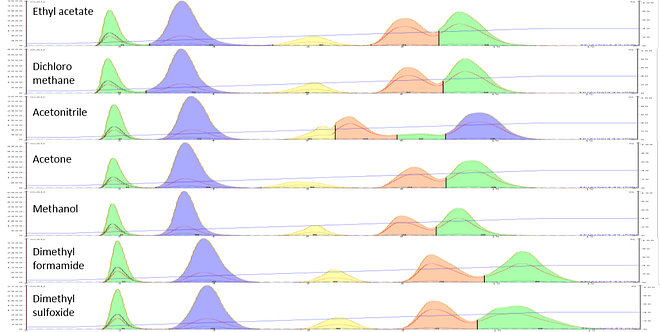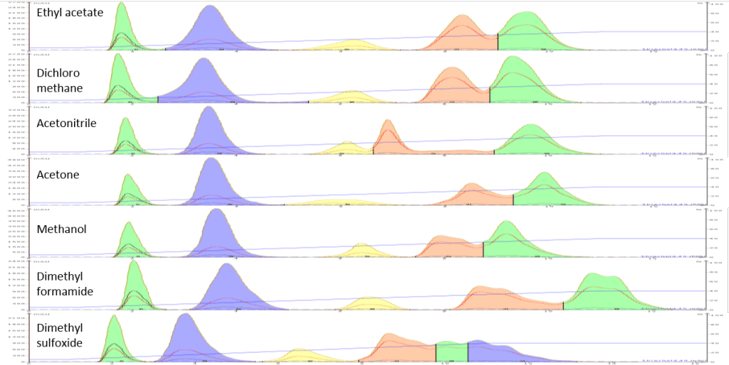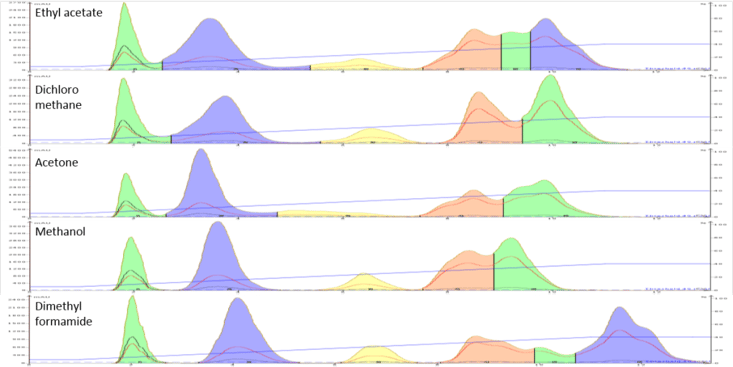In past posts I discussed which solvents work best for sample loading in reversed-phase flash chromatography. Recently, I was asked to provide some insight as which solvents are best in normal-phase flash column chromatography.
Liquid loading of samples onto chromatography columns is not always straight-forward. If your sample is dissolved in the mobile phase, that can work but may not be the best choice, especially if running a gradient.
In this post I show you some work I have done that opens up quite a few options for solvents used for loading samples and some surprising results with DMF.
Normal-phase flash column chromatography is the most commonly used form of purification in organic and medicinal chemistry labs. Many syntheses are conducted in relatively non-polar solvents which helps maintain solubility during the reaction while other reactions require higher polarity solvents. If a reaction can be accomplished with minimal heating, the non-polar solvents can work well but if high reaction temperatures are required, higher boiling solvents such as DMF are used.
With normal-phase chromatography you have a polar stationary phase in the column/cartridge while the mobile phase is more non-polar. Solvent combinations of hexanes or heptanes with ethyl acetate as the polar modifier are quite common for the purification of non-polar to moderately polar compounds. Compounds that are more polar often require a solvent combination of DCM and methanol, though this can be tricky. An alternative to DCM/MeOH is DCM/MeCN.
For method development and optimization in normal-phase I always recommend TLC to help determine which solvent blend to use and at what ratio.
Choosing the correct sample solvent (i.e. dissolution solvent) can make or break your purification. Choose a solvent that is too strong and you risk your purification quality, especially if your volume load is relatively large compared to the column volume.
Ok, then how do you choose the right sample solvent? Well, you can always do an empirical study (as I have done for this post) or read on below.
For this study I evaluated seven different solvents (Table 1) as diluents for a 5-component mix, Table 2.
Table 1. Evaluated solvents and their properties
| Solvent | Elutropic Strength (silica) | Dipole | Snyder Polarity Index |
| DCM | 0.32 | 1.14 | 3.4 |
| DMSO | 0.41 | 4.1 | 6.5 |
| EtOAc | 0.38-0.48 | 1.88 | 4.3 |
| MeCN | 0.5 | 3.44 | 6.2 |
| Acetone | 0.47-0.53 | 2.69 | 5.4 |
| MeOH | 0.73 | 2.87 | 6.6 |
| DMF | ? | 3.86 | 6.4 |
Table 2. Test mix components
| Compound | Amount (g) |
| Naphthalene | 1 |
| 1-Nitronaphthalene | 1 |
|
3,5-Dibenzyloxyacetophenone |
1 |
| Butyl paraben | 1 |
| Methyl paraben | 1 |
I prepared stock solutions of 1 gram of each component in 5 mL of acetone, 5 mL of DMF, and 5 mL of DMSO. To create the other stock solutions I evaporated 1-mL of the acetone stock in a 20-mL scintillation vial on a Biotage® V-10 Touch system followed by re-dissolution in 1-mL of methanol. I repeated this process for acetonitrile, ethyl acetate, and DCM. This provided me with seven stock solutions all at a ~1g/mL concentration.
Dilutions of the stock solutions of 1:1, 1:2, and 1:5 were created. Each stock solution and the dilutions of each stock were injected on new 5 gram Biotage ZIP® columns and eluted using a 5-40% hexanes/ethyl acetate gradient. Injection volumes were increased to maintain a 50 mg total sample load for every run.
The results show that at high sample concentrations and low injection volumes (<1.5% of a column volume or CV) virtually every solvent evaluated was suitable, the exception being acetonitrile. Beyond 1.5% of a CV the chance of success falls off.
Figure 1 shows the chromatography obtained with an injection volume of 0.1 mL of the 1:1 diluted samples (1.25% of the column CV). I am not showing the data for 0.05 mL (0.6%) injection volumes as they all looked good.
 Figure 1. Comparison of seven different injection solvents on the separation of a 5-component mix at 0.1 mL volume (1.25 % of the column's volume (CV)). All but acetonitrile provide separations but note the variation in elution times.
Figure 1. Comparison of seven different injection solvents on the separation of a 5-component mix at 0.1 mL volume (1.25 % of the column's volume (CV)). All but acetonitrile provide separations but note the variation in elution times.
If you take a look at the chromatograms in Figure 1 there are a few things I wish to highlight…
- All separations, except for the acetonitrile injection, are showing a similar separation pattern
- Retention of all peaks is longer with both DMF and DMSO injections (this was seen at the 0.6% load as well). Not sure why this is happening.
- The separation between the last two peaks is best with the DMF injection (also noticed at the lower 0.6% load).
- The MeOH injection results show faster elution of all components which all appear sharper compared to the peaks from the other injection solvents.
What the data in Figure 1 shows is that the solvent choice has minimal, if any, impact on the chromatography as long as the volume injected is <1.5% of a column volume and your sample solvent is not acetonitrile, at least for my sample mix.
In Figure 2 you can better see the impact of solvent choice when the injection volume was increased to 1.9% of a CV (0.15 mL). For this series of tests the 1:2 dilution samples were used to maintain the same 50 mg load.
At this load volume the separations created for several of the injected solvents are impacted, especially DMSO, MeOH, and acetone. With DMSO we have lost the long compound retention seen at lower volume loads as well as any defined separation of the parabens.
Methanol’s impact is seen in the resolution loss between the parabens due to some de-banding and band broadening. Acetone’s impact is seen with much wider peaks, especially the last three compounds. The results from Figure 2 also show that the strange separation obtained with acetonitrile in Figure 1 was not an aberration.

Figure 2. Comparison of seven injection solvents at 0.15 mL (1.9% of the cartridge's CV). At this load separation degradation is seen with DMSO, methanol, acetone and ethyl acetate. DCM and DMF still provide a good separation even though the peak shape with DMF is deteriorating.
To determine if any solvent was suitable for a larger injection volume a final test was performed using the 1:5 sample dilutions. The injection size was increased to 0.3 mL (3.8% of a CV) to maintain the same sample load of 50 mg. The larger volume further exacerbates the problem but also provides very helpful knowledge about which solvents should be considered for sample dissolution if larger injection volumes are required, Figure 3.
 Figure 3. Comparison of five injection solvents at 0.3 mL (3.8% of the CV) shows only DCM and DMF maintain a suitable separation for this 5-component sample. DMF does show peak shape distortion but does maintain the separation of the last two eluting peaks.
Figure 3. Comparison of five injection solvents at 0.3 mL (3.8% of the CV) shows only DCM and DMF maintain a suitable separation for this 5-component sample. DMF does show peak shape distortion but does maintain the separation of the last two eluting peaks.
In Figure 3 we see now that only DCM and DMF (at least for this sample) provide suitable chromatography at this injection volume. Even with some de-banding within peak 4 (pink) there is still an excellent separation between it (butyl paraben) and methyl paraben (last peak, blue) with the DMF injection. Ethyl acetate, acetone, and methanol injections have degraded the separations of last pair of compounds to the point where they are not separated well and will provide low purity for the collected fractions.
I must admit I do not understand why DMF appears to work as a sample diluent for normal-phase flash chromatography, as it is very polar and basic. These are two traits that should minimize its effectiveness as a normal-phase sample solvent because DMF should be preferentially adsorbed over almost anything else.
So, the bottom line is try to use a solvent capable of dissolving large amounts of your crude sample. Dichloromethane is a good choice but for hard to dissolve polar materials you may want to try DMF. And always try to minimize the sample volume and maximize the concentration.
I have added a loading guideline based on flash column size at a ~1.5% volume load, Table 3.
Table 3. Loading guidelines
| Column size (g) | CV (mL) | Max. injection volume (mL) |
| 5 | 9 | 0.15 |
| 10 | 15 | 0.25 |
| 25 | 42 | 0.65 |
| 50 | 80 | 1.20 |
| 100 | 150 | 2.25 |
| 200 | 310 | 4.65 |
| 350 | 530 | 7.95 |
Interested in learning more, download our whitepaper - Successful Flash Chromatography.

 Organic Workflow
Organic Workflow Peptide Workflow
Peptide Workflow Scale-Up Flash Purification
Scale-Up Flash Purification  Sample Preparation
Sample Preparation Biomolecule Purification
Biomolecule Purification Oligo synthesis
Oligo synthesis Scavengers and Reagents
Scavengers and Reagents Service & Support
Service & Support Accessories & Spare parts
Accessories & Spare parts Investors
Investors Reports & News
Reports & News The Share
The Share Corporate Governance
Corporate Governance Calendar
Calendar Sustainability
Sustainability Our Offering
Our Offering Our History
Our History Our Locations
Our Locations Leadership
Leadership